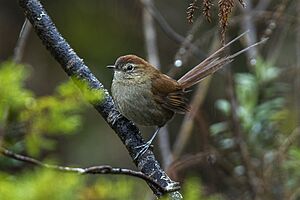White-chinned thistletail facts for kids
Quick facts for kids White-chinned thistletail |
|
|---|---|
 |
|
| Conservation status | |
| Scientific classification | |
| Genus: |
Asthenes
|
| Species: |
fuliginosa
|
| Subspecies | |
|
See text |
|
 |
|
| Synonyms | |
|
Schizoeaca fuliginosa |
|
The white-chinned thistletail (Asthenes fuliginosa) is a small bird that lives in the mountains of South America. It's part of the ovenbird family, known for building unique nests. You can find this bird in countries like Colombia, Ecuador, Peru, and Venezuela. In Ecuador, it's also called "colicardo barbiblanco."
Contents
About the White-chinned Thistletail
The white-chinned thistletail has four different types, called subspecies. Think of subspecies as slightly different versions of the same animal that live in different places.
- A. f. fuliginosa
- A. f. fumigata
- A. f. peruviana
- A. f. plengei
These birds used to be in a different group called Schizoeaca. But scientists used special tests to look at their genes. They found out that these birds actually fit better into the Asthenes group. It's like finding out a cousin you thought was from one side of the family is actually from another!
What Does It Look Like?
The white-chinned thistletail is about 18 to 20 centimeters (7 to 8 inches) long. That's about the length of a regular pencil! It weighs between 14 and 20 grams, which is about as light as a few quarters. It's the biggest type of thistletail bird.
Both male and female white-chinned thistletails look the same. They have a dark, brownish-black face with a faint grayish stripe above their eye and a whitish ring around their eye. Their head, back, and tail are a dark reddish-brown color. Their wings are a brighter reddish-brown.
One special thing about this bird is its tail. It's long and split at the end, looking a bit ragged because the feathers don't have many small branches (called barbs) at their tips. The bird's chin is whitish, and the rest of its belly is grayish, turning a bit brownish on the sides. Their eyes can be different colors, and their beak is usually dark with a lighter pinkish or whitish bottom part. Their legs and feet are blue-gray.
The different subspecies mostly vary in the color of their upper parts. Some might have darker backs, duller colors, or a longer, whiter stripe above their eye.
Where Does It Live?
The white-chinned thistletail lives in the high mountains of South America, specifically the Andes. Each subspecies lives in a slightly different area:
- A. f. fuliginosa: Found in Venezuela, the eastern mountains of Colombia, and the Andes of Ecuador.
- A. f. fumigata: Lives in the central mountains of Colombia.
- A. f. peruviana: Found in the northern Andes of Peru.
- A. f. plengei: Lives in the central Andes of Peru.
These birds like to live in high-altitude grasslands called páramo, misty "elfin forests" (which are forests with small, twisted trees), and the edges of "cloudforests." They also like dense bushes where the trees stop growing at high elevations. Sometimes, they can be found in special woodlands with Polylepis trees.
They usually live at heights between 2,800 and 4,000 meters (about 9,200 to 13,100 feet) above sea level. That's really high up in the mountains!
Behavior
What Does It Eat?
The white-chinned thistletail mainly eats small bugs and spiders, which are called arthropods. It also sometimes eats tiny seeds. This bird usually looks for food by itself or with a partner. It rarely joins big groups of different bird species that are feeding together. It searches for food in the lower parts of trees and bushes, picking insects off leaves and small branches. Sometimes, it does amazing acrobatic moves to reach its prey!
What Sounds Does It Make?
The white-chinned thistletail has several interesting songs and calls. One of its songs is a high-pitched, soft trill that gets a little faster and higher. Another song is a series of notes that go down in pitch and then speed up into a trill. It also has a song that sounds like "tididit, tididit, tididit" going slightly higher. For calls, it makes a sharp, high-pitched "pyeek" or "kick" sound, and sometimes a "chink."
How Is It Doing?
The IUCN (International Union for Conservation of Nature) has looked at the white-chinned thistletail and decided it is a species of "Least Concern." This means that, for now, it's not considered to be in danger of disappearing.
The bird lives across a large area, and while scientists don't know the exact number of these birds, they believe the population is stable. There aren't any big, immediate threats to them. However, the places where they live, especially the high-altitude habitats at the tree line, have been changed a lot by fires and animals grazing. This means their homes are getting smaller in some parts of the Andes mountains.


